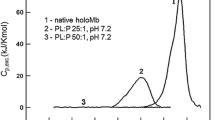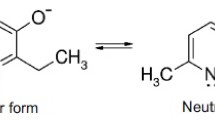Summary
Various classes of hydrophobic organic compounds of the aliphatic and aromatic series specifically inhibit electron transfer in the respiratory chain between NAD and cytochromeb. In liver mitochondria this effect can be reversed by vitamin K3. There is a quantitative correlation between the inhibitory activity of these compounds and the value of their partition coefficients in octanol-water.
By measuring the effect of the inhibitors on the surface tension at the heptane-water interphase, it has been shown that the concentrations of hydrophobic inhibitors in the water phase required to fill 50% of the interphase boundary area are very close to the concentrations of these substances which decrease the rate of mitochondrial respiration by 50%. The conclusion is drawn that the region of the NADH dehydrogenase which binds these inhibitors resembles, in its adsorbtional properties, the hydrocarbon-water interphase.
Anions of carboxylic acids and phenols with pKa<7.7 inhibit the respiratory chain before, and not after, NADH. Their effect is not reversed by vitamin K3. In this case, again, the efficiency of the inhibitor depends upon their lipid solubility.
The fact that electroneutral hydrophobic compounds inhibit the respiratory chain NADH dehydrogenase, whereas charged ones do not, is discussed in connection with the mechanism of action of this enzyme. It is proposed that, after reduction, the negatively charged carrier dissociates from the hydrophobic region of the enzyme.
Similar content being viewed by others
References
V. Horgan, T. Singer and J. Casida,J. Biol. Chem.,243 (1968) 934.
A. Stoppani, C. Brignone and J. Brignone,Arch. Biochem., Biophys.,127 (1968) 463.
E. Readfearn and T. King,Nature 202 (1964) 1313.
C. Hansch and S. Anderson,J. Med. Pharm. Chem.,10 (1967) 745.
R. Wedding, C. Hansch and T. Fukuto,Arch. Biochem. Biophys.,121 (1967) 9.
M. Stockdale and M. Selwyn,Eur. J. Biochem.,21 (1971) 416.
L. Grinius, T. Guds and V. Skulachev,Bioenergetics,2 (1971) 101.
M. Hansen and A. Smith,Biochim. Biophys. Acta,81 (1964) 214.
I. Getmansky and L. Bavika,The methods of water solution analysis of the surface active substances, v. 1, 1965.
A Weissberger.,Phys. Methods of Org. Chem., v.I, I. L. (1950).
L. Ratnikova, L. Yuguzhinsky and V. Skulachev,Biochemia (USSR),36 (1971) 376.
T. Fujita, J. Iwasa and C. Hansch,J. Am. Chem. Soc.,86 (1964) 5175.
C. Hansch, J. Quinlan and G. Laurence,J. Org. Chem.,33 (1968) 347.
D. Currie, C. Lough, R. Silver and H. Holmer,Canadian J. Chemistry,44 (1966) 1035.
L. Danielson and L. Ernster,Nature,194 (1962) 155.
A. Lehninger,J. Biol. Chem.,190 (1951) 345.
M. Gutman, C. Coles, T. Singer and J. Casida,Biochemistry,10 (1971) 2036.
E. Land and A. Swallow,J. Biol. Chem.,245 (1970) 1890.
A. R. Schulz and H. Goss,Biochim. Biophys. Acta,21 (1956) 578.
L. Ernster, L. Danielson and M. Ljunggren,Biochem. Biophys. Acta,58 (1962) 171.
Author information
Authors and Affiliations
Rights and permissions
About this article
Cite this article
Yaguzhinsky, L.S., Smirnova, E.G., Ratnikova, L.A. et al. Hydrophobic sites of the mitochondrial electron transfer system. J Bioenerg Biomembr 5, 163–174 (1973). https://doi.org/10.1007/BF01648987
Received:
Issue Date:
DOI: https://doi.org/10.1007/BF01648987




